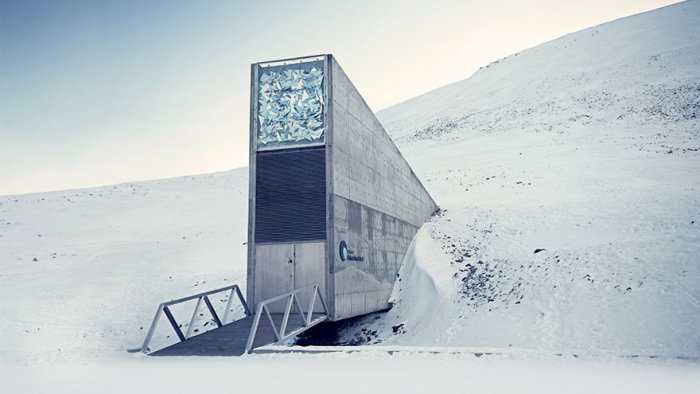
There are approximately 1700 sites across the globe that hold stores of plant seeds tucked away from, yet also for, civilisation. These places are called genebanks or “doomsday vaults” – a kind of depository that keeps the world’s most critical crop species safe from natural (or man-made) disasters so that in the event of a large-scale catastrophe, there are means to jump-start basic agriculture back to life.
Arguably the most important of these frozen vegetation vaults is the Svalbard Global Seed Vault. It is the largest of its kind and is located in the Norwegian archipelago of Svalbard, approximately 1300 kilometres from the North Pole.
The location was chosen to be the Mecca of genebanks for its remoteness (the site is the most northern place that can be reached by chartered aeroplane) and the natural permafrost that permeates the area ensures that the plant seeds inside stay frozen indefinitely even if the facility’s power fails. The Svalbard Seed Vault’s design allows its interior to remain unchanged for not just years, but centuries.
The vault has been in operation since 1984, but it only sees activity for a few days out of the year. For the vast majority of the time, it remains closed. The vault is currently home to roughly 860 000 plant samples from almost every country in the world. It has the capacity to safeguard 2.5 billion seed samples.
According to the facility’s website, the diversity of plant life held frozen there ranges from “unique varieties of major African and Asian food staples such as maize, rice, wheat, cowpea, and sorghum to European and South American varieties of eggplant, lettuce, barley, and potato. In fact, the Vault already holds the most diverse collection of food crop seeds in the world.”
Though the Svalbard Global Seed Vault’s utility is clear in the hypothetical event of a regional or global disaster, it is actually used more often to replenish other lesser genebanks. This vault acts as a safety net to other safety nets. It holds duplicates of plant seeds found in other genebanks. Such places quite regularly lose stores of seeds due to either lack of funding, mismanagement or equipment failure.
The entrance to the Svalbard vault has an art installation mounted over it that allows it to be spotted from a distance. The sculpture, named Perpetual Repercussion, was created by Norwegian artist Dyveke Sanne. It consists of shards of stainless steel, mirrors and prisms that reflect the Arctic lights during the winter months and is illuminated by a network of fibre-optic cables for the rest of the time.
The video below by Veritasium shows the inner-workings of the Svalbard Global Seed Vault.






